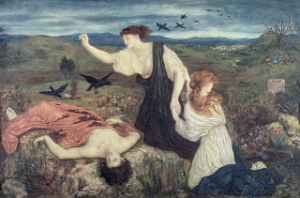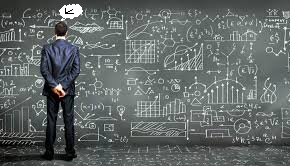
Arquivo para a ‘Cognition’ Categoria
Infinity and human complexity
Nothing weaker than wanting to arrest the man who makes him a hostage of ideas or static methods, so there is no thesis and antithesis, but to be and not to be, Husserl stated that “by conceiving ideas, man becomes a new man , who, living in finitude, is oriented towards the pole of infinity ”, but the idea here is the eidos of ancient Greece.
or static methods, so there is no thesis and antithesis, but to be and not to be, Husserl stated that “by conceiving ideas, man becomes a new man , who, living in finitude, is oriented towards the pole of infinity ”, but the idea here is the eidos of ancient Greece.
This concept comes from a Proto-Indo-European root “weid”, “see”, origin of the words, εἶδος (eidos) and ἰδέα (idea), according to the “American Heritage Dictionary”, and its pre-Socratic origin is linked the investigation of what things are in essence, and thus the idea of substance appears, as what a thing is independent of its changes in “shape”.
Edmund Husserl foreseeing that the idealistic philosophy that became fixed in forms and that no longer saw the essence would result, affirmed “philosophers, at present, are very fond of criticism instead of studying things from the inside”, it is due to this fact that we fixate on forms and effects without ever referring to the essentials and things.
This is how his phenomenological philosophy was established, it is necessary to return “to the very things”, in a famous expression by Husserl, and his phenomenology is this way back to things, to the world of lived experience or the “lebenswelt” (world-of-life) ) which is the opposite of the world of ideas, from Parmenides, through Plato, to Kant and Hegel.
Phenomenology was born from the social psychology of Franz Brentano recovered the idea of intentionality, coming from the ontological concept of consciousness, which itself highlights the most important point of this experience, that is, the intention clarifies the structure of what is conscious.
What is hidden in every experience, then, is the intention of what is conscious, and if all consciousness only makes sense as awareness of something, psychology deals with what is not conscious.
Self-help, spirituality and psychology
The difference is quite large, but for many, including bookstores, these issues are in the same session, making a joke I would say that the first one gives the idea that you alone resolve yourself (self-help) and the second you need a professional, so it is more expensive. However, the issue is deeper and more serious.
the same session, making a joke I would say that the first one gives the idea that you alone resolve yourself (self-help) and the second you need a professional, so it is more expensive. However, the issue is deeper and more serious.
Self-help has created a series of popular beliefs, for example, Rich Dad, poor son, so self-help suggests Rich Son, or Retired Young and Rich or Poor Father for young people, anyway the list is immense, if it were true everyone would say the same, but life does not have these magic formulas.
So, the objective of every self-knowledge process, including psychology is one, can be effective if it is based on real experiences and facts of a person’s life, so it cannot have a general formula, and this is as old as epistemic thinking “Know yourself”, but this must not be a doxa, that is, a mere unfounded opinion.
Clinical psychology, just to give an example, has found that our symptoms, our problems, our suffering arise and grow from unconscious sources, this means that there is a layer that we consciously have little access to, that give rise to what we are.
However, today there is an even more serious problem where charlatans and false promises of self-help reside, spirituality without a personal and social context, “unspiritualized asceticism” as stated by Peter Sloterdijk, a kind of catharsis or self-help that leads to fanaticism without spirituality.
Even to call it spirituality is a mistake, it is self-help with a manipulated religion and unfounded beliefs, but true spirituality exists, and it is a way of providing balance and helping us with unconscious sources of problems or even solutions.
Anyway, it would be good to separate the three fields, personal, social and work self-help formulas, clinical treatment of psychological problems and true spirituality that does not co-exist in all three, a form of personal or community asceticism that leads to improved relationships and greater happiness conviviality.
Between fantasy and imaginary
The imaginary is part of popular culture and tradition, countless cultures express  themselves, seem myths and fantasies were from reality, but it differs from this in having an original source, that is, being part of a culture and expression of desires and perspectives cultural aspects of a people.
themselves, seem myths and fantasies were from reality, but it differs from this in having an original source, that is, being part of a culture and expression of desires and perspectives cultural aspects of a people.
What Droysen, Heidegger and Gadamer speculated about romantic historicism, which Dilthey elaborated, is nothing but fantasy historicism, the future as a pure unrealizable dream while the future to come is part of the cultural tradition and that is why dialogue with tradition is necessary.
Fantasy is initially an attempt to escape, the absence of dialogue not in the prosaic sense of listening to the Other, of accepting difference, but of truly understanding and dialoguing by entering into the concepts and perspectives present in tradition, without understanding it, we listen and not the dialogue, the dialogue that Martin Buber, Paulo Freire and even Bakhtin spoke about.
The fantasies represent delusions of the soul, uncontrollable compulsive desires, and which often reach pathologies, it is not a childish fantasy of fairy tales or superheroes, these belong to the imaginary because the child still sees the future world as a possibility. The epic imaginary, both as historicism and as literature, highlights the deeds and glories, where the present appears as a result of a mythical past, but which is projected into the future, expresses the factual exaltation of memorable or extraordinary events.
The romantic imaginary is that of a lonely hero displaced in time, Don Quixote is a good expression of this imaginary, it represents a reaction to the philosophical saturation of determinism and rationalism, but he is stuck with the empirical sensory or the metaphors of the real.
These fantasies in general appeal to creativity, but say little about reality
Tragedy and the arts
I am not speaking here of tragedy in the ordinary sense, but as an artistic category that is not only important for understanding the arts and beautiful Greek, but is claimed as a new idea of tragedy “as proposed by Hölderlin, Hegel or Nietzsche.” (Ranciére, 2009, p. 25).
sense, but as an artistic category that is not only important for understanding the arts and beautiful Greek, but is claimed as a new idea of tragedy “as proposed by Hölderlin, Hegel or Nietzsche.” (Ranciére, 2009, p. 25).
Just as Byung Chul Han in “The Salvation of the Beautiful” will problematize the dualism between contemplation and action, typical of modern philosophy that separates subject from object, Rancière penetrates further by proposing his “aesthetic revolution”, stating that what is there is “The abolition of an ordered set of relations between the visible and the sayable, knowledge and action, activity and passivity” (Ranciére, 2009, p. 25).
I said this when analyzing the Oedipus of the “psychoanalytic revolution” that invalidates “those of Corneille and Voltaire and who intends to resume – beyond the French tragedy, as well as the Aristotelian rationalization of tragic action – as the tragic thought of Sophocles” (idem , p. 25).
Ranciére will discuss in the following pages of his chapter on the “aesthetic revolution” on psychoanalysis saying that it is “invented at that point in which philosophy and medicine are mutually questioned to make thinking a question of disease and disease a question of thinking ” (Ranciére, 2009, p. 25), in paint above Marie Spartali Stillman (1844–1927),.
A large part of modern neo-therapies (I call exoteric psychoanalysis) go around, as if the problem of idealistic thinking was “disease” and a large part of human suffering could be solved as “thought” transforming it into disease.
This happens due to a bad relation with the thinking of tradition, late modernity is nothing but the bad reading of rationalism and idealism, or the delayed reading of empiricism, the thinking of Hanna Arendt’s “active” action, expressed in Byung Chul Han , is also part of the thinking of tradition that Ranciére will identify in the “representative regime as an absolute power of making” (Ranciére, 2009, p. 27).
It clearly identifies this regime in Baumgarten’s discourse on “confused clarity”: “in the aesthetic regime, this identity of knowledge and non-knowledge, of acting and suffering, which… constitutes the very way of being of art ”(Idem, p. 27), of course this is the art of tradition. And so it says, that the aesthetic revolution had already started with Vico, in his New Science, who against Aristotle and the representative tradition, although Rancière knows that his problem was not the theory of art, but the theological-poetic problem of “ wisdom of the Egyptians ” about hieroglyphs.
Bruno, besides the heretic
I read in my youth Giordano Bruno’s “La cena de las cenizas”, one of six dialogues written in Italian, written during his two-year stay in London (1583-1585).
written in Italian, written during his two-year stay in London (1583-1585).
The Dominican priest discussed the Copernican Revolution in this book, and although he was accused of heretic, his discussion was no other than Christian eschatology in his worldview beyond his time glimpsing the ways of the infinite world and his view of God.
He paid with his own life, being burned alive on February 17, 1600 in Rome, but all his commentators claim that their dialogue opened the way for a new link between the paths of cosmology and philosophy, but contrary to the medieval Christian worldview.
His philosophy went beyond the limitations of reason (mathematical and logical) using for his bold vision an amalgamation of basic facts and cosmic reality, but without neglecting a reflection that led to humanistic action.
Also fleeing empiricism and using mental experiments from which he deduced the ramifications of his worldview, some interpreters claim that he used reasoning similar to what Einstein used for his intuitions about the universe.
Referring to the cosmos as infinite reality, Bruno went beyond the spheres of Aristotle and Ptolemy, to him as well as to Kepler, Paracelsus and Nicolas de Cusa the universe is a living being that holds an essential unity that unites all particular beings, which are but emanations of the whole, this cosmological view influenced the entire Renaissance.
His worldview, which did not triumph in the Renaissance, perished and was interrupted by the emergence of Cartesian reason, Hume’s idealism and empiricism, but deserves to be reread and studied as a strong influence on Renaissance thought.
Here’s what was said about Giordano Bruno in the famous cosmos series:
https://www.youtube.com/watch?time_continue=6&v=XzTREw3AKEQ&feature=emb_logo
Complex thinking
Nothing favors obscurantism more than the idea that is possible to make what is complex simpler, ignore the organicity of social, ecological and cultural problems and how they compose themselves.
that is possible to make what is complex simpler, ignore the organicity of social, ecological and cultural problems and how they compose themselves.
Complex thinking is born from the idea of nature and the universe as organisms that are increasingly mysterious and whose structure is gradually revealed, through the hard work of those who first admit the complexity of phenomena and second resist temptation to simplify them by imagining that simple solutions and ideas would be enough to solve them.
Man himself is but a complexification of nature, they agree with this not only the most elaborate scientific thought but also theologians like Teilhard Chardin.
Scientific simplification is called reductionism, religious simplification reductionism, cultural and social simplification has no specific name, but it can be said that it is confused with ignorance and dualism.
Morin explains in Introduction to Complex Thinking: “the ancient pathology of thought gave an independent life to the myths and gods it created. The modern pathology of the spirit is in the hypersimplification that makes it blind in the face of the complexity of the real” (Morin, 2008 p. 22).
In the scientific field explains it epistemological blindness: “Those disputed between Popper, Kuhn, Lakatos, Feyerabend, etc., are ignored. Now this blindness is part of our barbarism. It makes us understand that we are always in the barbaric age of ideas. We are always in the prehistory of the human spirit.” (Morin, 2008, p. 23).
Nothing more complex than reducing it to the simple, as Bachelard stated, there is no simple, there is only simplified, which most often mutilates and deforms the phenomenon, inducing thought to obscure liquidity.
Morin, E. (2008) Introduction to complex thinking. 5th. ed. Lisbon: Institute Piaget.
A re-reading of the three wise men
In times of fundamentalism and religious intolerance, a re-reading of the Magi that they  have adopted and also “contemplating” the birth of Jesus is essential for dialogue.
have adopted and also “contemplating” the birth of Jesus is essential for dialogue.
The first necessary is that God has communicated with the “wizards” of the East, he can reopen closed hearts for reconnection (religion of the Latin verb religare which is to reconnect), for they were not even religious in the conventional sense, but
magicians and God reconnected them.
The second is that the divine communication was through stars, which means that they could understand this language and that God spoke in their human language, that is, there are forms beyond the dogmatic communication between God and men, even non-believers.
Cosmology is an ancient and fundamental part of philosophy, its evolution and composition studies the universe, and comes from antiquity, the pre-Socratics studied it, also seek the explanation of the origin and transformation of nature and the universe and build myths and divinity, creating a relationship between mortal and imortal beings.
So God is not so indiferente to this, a universal proposition should not disregard cosmology, and if one wishes to construct a cosmogony, that is the beginning and end of all life, then an eschatology is also constructed, and Christian eschatology may be related to Is not this, after all, God the beginning and the end of everything?
Thesecond re-reading, the question about of the stars, in fact even today they are looking for cosmological evidences ofthe star that the Magi followed, a star, a come t, this could help to date Christmas of a more precise date.
Theologians such as Teilhard Chardin did not fail to consider the cosmological hypothesis, and the notion of a Christ-centered universe helps a non-fundamentalist interpretation of a more complex eschatology, and so we have recourse in the previous post (in 1 / 4 /2019) to St. Gregory of Nazianzen.
The third is that the magi were “contemplating” the boy-God, in addition to the active vita, Hannah Arendt also spoke of her in The Human Condition (published in 1956, with Brazilian edition of 2009), which comes from the conference Work, Work and Action (Brazilian publication of 2006), but already spoke of this question Aristotle in the bios politikos and the vita negotiosa or actuosa in Augustine, and, recently Byung Chull Han in The society of the fatigue.
But they did not come to worship only, where the element offered incense is essentially this, but also brought gold in the sense of wealth and myrrh in the sense of sacrifices offered.
Magi should signify the opening of Christianity to other languages which are also an expression of the infinite, of the universe, and of the sacredly constructed life in all and in all.
Spirit, World and unit
There is something in our consciousness that we can not define exactly what it is, a spirit, a mechanism of decision, a “vision of the world,” the certain thing is that what we call interiority has a deep layer that the philosophers of classical antiquity have called of “anima”, that which gives life, that animates and that is ultimately also a vision of the world.
a mechanism of decision, a “vision of the world,” the certain thing is that what we call interiority has a deep layer that the philosophers of classical antiquity have called of “anima”, that which gives life, that animates and that is ultimately also a vision of the world.
Whether we like it or not, we have in the interior an “anima”, already the pre-Socratic philosopher Pythagoras (580-496 BC) believed in the metempsychosis that was the transmigration of the soul from one body to the other after death, and so in his worldview he believed in immortality of the soul.
Plutarch was also the author of “Consumption of the Flesh”, a theme that not only speaks of the soul, but initiates a separation between the body of the flesh and the immortal soul.
The theme is deepened by Plato in The Republic, his anima mundi (“soul of the world, from ancient Latin had another sense that was the” psyché tou pantós “), has the worldview of a shared soul or regent force of the universe by which the divine thought can manifest itself in laws that affect matter, so there is an immaterial force, which is at the same time inseparable from matter, which provides form and movement.
His doctrine was not endorsed by Aristotle, who in his work De anima, approaches more knowledge or active intellect, from which reflect from the Stoic and Neoplatonic schools, so the indirect link between Plotinus and Plato passes through Aristotle.
Plotinus will be a rare philosopher of antiquity attempting a non-dualistic concept of soul, the soul described in his work Eleades, part of the concept of the hypostasis that proceeds from the creative power, which is actually a third hypostase, a nous that generates the soul of the world.
Among the medieval thinkers who maintained the ideas of the anima mundi are Ficino, Pico dela Mirandola and Giordano Bruno with hermetic teachings, Cambridge pioneers, German vitalists Angelus Silesius, Goethe and Schelling, who had great influence on Bergson and through him Vladimir Vernadsky and Teilhard de Chardin.
Schelling wrote The Soul of the World (1798), although idealist influence guarded a worldview trying to unite organic and inorganic nature by connecting it to a continuum.
The noosphere here is the idea that a “soul-world” can cooperate with the contemporary world and a totalizing vision, the world view of the planet as a “common house” and that has a “soul-world” present and can not sustain a citizenship. Roger Scruton (75 years) is a contemporary author who tackles controversially the theme.
The noosphere here is the idea that a “soul-world” can cooperate with the contemporary world and a totalizing vision, the world view of the planet as a “common house” and that has a “soul-world” present and can not sustain a citizenship. Roger Scruton (75 years) is a contemporary author who tackles controversially the theme.
Gratitude, the question of science and common sense
A person may be grateful without understanding the goals of gratitude, but they will not understand the goals if they do not know the true motivations of gratitude, that is, remaining in gratitude can be free of knowledge, but have gratitude (make it a habit healthy) requires going beyond the simple gratuitous act, knowing it and cultivating it to work in society.
they will not understand the goals if they do not know the true motivations of gratitude, that is, remaining in gratitude can be free of knowledge, but have gratitude (make it a habit healthy) requires going beyond the simple gratuitous act, knowing it and cultivating it to work in society.
Thus, it is necessary to separate appreciable common sense from objective knowledge, which is to dissect the object of knowledge that can be done both inductively and intuitively, both paths are valid, so it is not necessary conventional but intentional science.
To talk about science we need to talk about Karl Popper, he also speculated about being things, said about common sense is valid, but upholding the truths of it is something bigger. But objective knowledge, he said, was an eternal pursuit of his life, in his words: “The essays in this book break with a tradition that can be traced back to Aristotle – the tradition of this common sense theory of knowledge.
I am a great admirer of common sense, which I claim is essentially self-critical ”, But to uphold it as truth requires more: “… if I am willing to uphold to the end the essential truth of common sense realism, I regard the common sense theory of knowledge as a subjectivist blunder.
This blunder has dominated Western philosophy, ”as understood by feelings, passions, and even sustaining nonobjective questions.
He goes on: “I have been trying to eradicate it and replace it with an objective theory of knowledge, essentially conjectural. This may be a bold claim, but I do not apologize for it ” (Popper, 1975, p. 07).
Popper’s division into three worlds shows a weakness in his theory by separating knowledge into three worlds: P1 the world of nature (or physical in the sense of physis), the world of minds (World 2) and the world of ideas (World 3), prioritizes the latter.
In a solution to a problem, people can attack or accept the solution found, but not the person who presented it, so it gives a greater value than the world of ideas (World 3) has to Popper, rather than the World of minds (World 2) who developed them.
Gratitude is just the opposite, because the minds that develop solutions to the problem (World 2) are more important than the ideas that drive them (World 3), although subjectivism, which is proper to the subject, may also have weaknesses.
What embraces these three distinct aspects: Nature, Knowledge and Ideas, are ontological aspects, for the three are proper to Being, gratitude is one of these aspects.
In times of a pandemic vaccine, it is good to remember Popper because he said that what can be refuted is scientific, and what we today is an “affirmation” or “denial” about vaccine, both is anti-scientific, the longer tests is need.
Popper, K. (1975) Conhecimento objetivo (Objective Knowledge). Brazil, São Paulo: Editora da Universidade de São Paulo.
Serenity, diagnosis and education
The apparent cause of our day-to-day problems seems to be the latest advances, innovations, social life, social media “media” and human work in many areas, we embark on the easy discourse of liquidity, hypercommunication, and excess information, this diagnosis is correct.
innovations, social life, social media “media” and human work in many areas, we embark on the easy discourse of liquidity, hypercommunication, and excess information, this diagnosis is correct.
With the wrong diagnosis, we prescribe the wrong medicine, put more exercise into our lives, an exercise life, Sloterdijk would say, more natural food and more active life for it, fault of diagnosis error and absence of a clear future.
The clearing can only come from the thought, the appeal to practice is the worst remedy we have not have a weekend of rest and recreational activities because there are matters “urgent.”
The diagnosis of this current drama was already in Nietzsche (1834-1900), wrote in Human too Human: “For lack of rest our civilization is headed for a new barbarism. At no other time did the assets, that is, the restless ones, avail so much. Thus it belongs to the necessary corrections to be made as to the character of humanity to greatly strengthen the contemplative element, ‘a clear indication of the date of the present problem.
It may even be earlier, Kierkegaard (1813-1855) wrote: “the remedy for anxiety is to be as we truly are,” pointing out at the beginning of modernity the ontological problem of which humanity suffers a great deal, wanting to be what one is not , even if the daring and the search for new horizons is good, it must be done in solidarity with the Other.
The diagnosis, said Priest Manuel Antunes, whose birth celebrated 100 years on November 3, is to counter the homo mechanicus, the fruit of modernity, which created what the Portuguese wise man called “foam man”: light, without consistency, without fidelity and without strong convictions.
The education that must follow must be highly dialogic, comprehensive and transdisciplinary, defended Father Manuel Antunes, defend Edgar Morin, Basarab Nicolescu and so many others, however a method is necessary so that it does not stop in the speech.
The method proposed by Gadamer in his reading of Heidegger is the hermeneutic circle, the possibility that from preconceptions we arrive at a fusion of horizons and a greater possibility of re-reading of the present time, outlining ways for the future.

